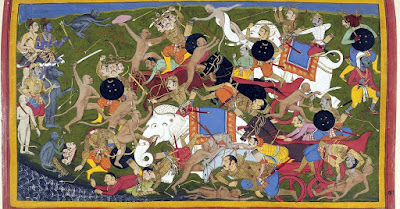POINTS TO REMEMBER IN ENGLISH LITERATURE- SERIES 3
1. Jeremy Taylor (1613- 1667) was a clergy during the victory of the parliament over the king. He is also known as the ' Shakespeare of Divines ' and is often considered one of the most prolific prose writers in English Literature. Lesser Festival is observed in his honor on August 13.
2. The Liberty of Prophesying (1646) by Jeremy Taylor is an appeal for toleration. John Locke's Letters Concerning Toleration(1689) has been written on the same line.
3. Letters Concerning Toleration (1689) has been addressed to Philip Van Limborch, Locke's close friend. In the letter, he has spoken of his fear of Catholicism undermining the Protestant faith. He has also appealed for religious toleration.
4. An Essay Concerning Human Understanding(1689) has been one of the most influential works by John Locke(1632-1704). A prominent figure in the Age of Enlightenment, he is also known as the ' Father of Liberalism.'
5. The Age of Enlightenment also brought to the surface the work of David Hume, A Treatise of Human Nature. The social and intellectual movement in the 18th century across Europe had works based on education, political framework, and others. He was a Scottish philosopher.
6. Adam Smith, a Scottish philosopher published in 1776 The Wealth of Nations. It is now the most important work for present-day economists.
7. A Vindication of the Rights of Woman: with Strictures on Political and Moral Subjects (1792) written by Mary Wollstonecraft, is one of the earliest works on Feminism. (PAPER 2, 2004, Q11)
8. The Social Contract, also known as On the Social Contract or Principles of Political Right (1762), is written by Jean Jacques Rousseau. He has also written Discourse on Inequality(1755).
9. Jonathan Swift (1667-1745) was an Irish. His prose works contained satire, pamphlets, essays, and books on voyages. He is less known for his poetry. His satires were styled after Horace and Juvenal.
10. Allegory is a literary device in which character, event, and place are used as a symbol to convey a partially hidden or complicated meaning which has a social, political, moral, and spiritual bearing on the day-to-day happenings.
11. The Battle of the Books is a satire written by Jonathan Swift. In this, the books have been shown fighting in the King's Library at St. James' Palace. The title of the work has now come to depict the fight between the ancients and the moderns.
12. A Tale of a Tub Written for the Universal Improvement of Mankind (1704) is the most complex satire by Jonathan Swift. Written in prose, it parodies the Roman Catholic and Protestant faith. The book was attacked for its satire on religion by William Wotton. (PAPER 2, Q12, 2004)
13. Jonathan Swift wrote under various pseudonyms- Lemuel Gulliver, Issac Bickerstaff, M.B Drapier or even anonymously.
14. Gulliver's Travels(1726) is a satire on human nature written in four parts by Jonathan Swift. This work is often considered as a rebuttal to Daniel Defoe's Robinson Crusoe. The English dramatist John Gay considered it to be a widely read book among all age groups.
15. A Modest Proposal, a satirical essay written in Juvenalian style, was published anonymously by Jonathan Swift in 1729. It criticises the British attitude towards the Irish. It proposes the poor Irish sell their children off as food to the rich to reduce their economic hardships.
16. William Blake (1757-1827) known for his visual artistry and prophetic works in English belonged to the Romantic Age.
17. William Blake in his prophetic works built a mythology. Therein, he wrote his political and spiritual views that he felt were prophetic and would come true in the future. His inclination to create his own mythology also depicts his internal struggle with freedom and order.
18. Milton's Paradise Lost and Regained, the Bible and Emanuel Swedenborg were his inspiration in creating prophetic works.
19. The Song of Los, one of Blake's epic poems was pubished in 1795. The poem has been divided into two sections - Arica and Asia. It is aimed at the loss of morality in Europe.
20. The Song of Los has been the background for his other works- The Book of Urizen, The Book of Ahania and the Book of Los.
21. Songs of Innocence and Experience was first printed in the year 1789. Later, when printed in the second phase after five years, it came to be known as Songs of Innocence and Experience Showing the Two Contrary States of the Human Soul.
22. The transition of human experience is shown in Songs of Innocence and Experience. It is related to Milton's duality of Paradise( the unfallen state) and Fall( the fallen state).
23. Poetical Sketches is a collection of prose and poetry written between 1769-1777 by Blake. This is the first collection by Blake printed in 1783.
24. The literary influence in Poetical Sketches includes James Thomson's The Seasons( 1726-1730), Horace Walpole's The Castle of Otranto(1764), James Macpherson's Ossian (1761-65), Thomas Percy's Reliques of Ancient English Poetry(1765), Edmund Spenser, Shakespeare, Miton and such others.
25. Considered to be a sequel to the Book of Thel, William Blake's 1793 poem Visions of the Daughter's of Albion is one of his prophetic works. He was influenced by Mary Wollstonecraft's ' A Vindication of the Rights of Woman' published in 1792 in the creation of Oothon, a female character called ' the soft soul of America'. (PAPER 2, Q13, 2004)


Comments
Post a Comment